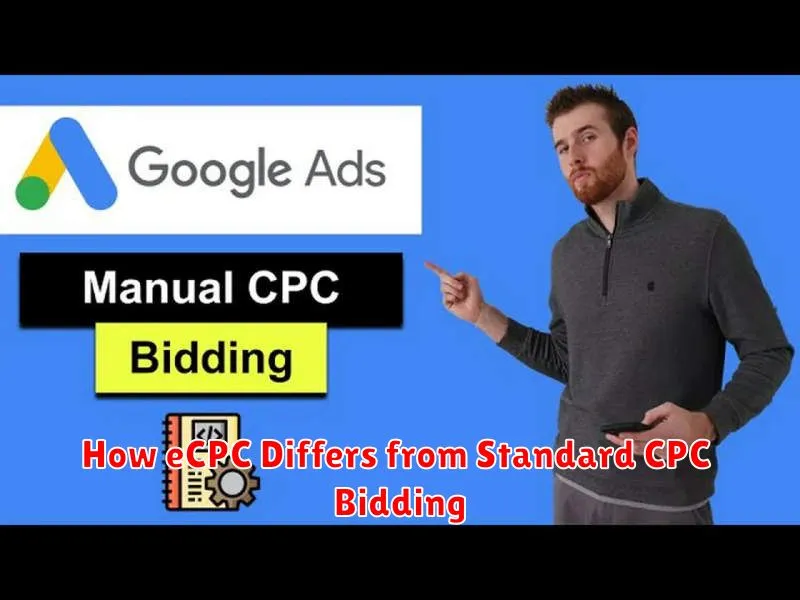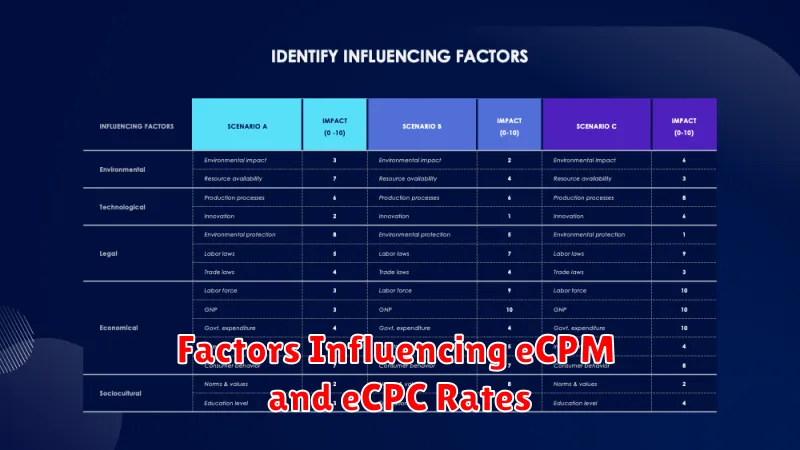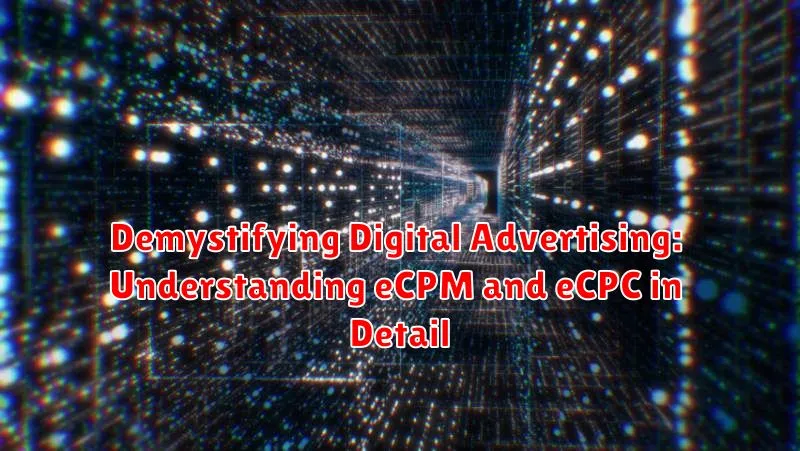In today’s dynamic digital advertising landscape, understanding the nuances of performance metrics is crucial for maximizing return on investment. This article aims to demystify two essential metrics: eCPM (effective cost per mille) and eCPC (effective cost per click). We will delve into their definitions, calculations, and practical applications, providing a comprehensive overview that empowers both seasoned marketers and newcomers to the field to make data-driven decisions. Gaining a firm grasp of these concepts is paramount for optimizing ad campaigns, effectively allocating budgets, and ultimately achieving desired business outcomes in the competitive digital marketing sphere.
eCPM and eCPC are not simply numbers; they are indicators of campaign efficiency and performance. eCPM, representing the estimated cost for one thousand ad impressions, provides a standardized measure of the revenue generated per impression, while eCPC reveals the effective cost incurred for each click on an advertisement. By analyzing these metrics, advertisers can gain insights into the effectiveness of different ad formats, targeting strategies, and bidding approaches. This detailed exploration will provide a valuable toolkit for navigating the complexities of digital advertising and achieving superior campaign performance across various online advertising platforms.
What is eCPM (Effective Cost Per Mille) and How is it Calculated?
eCPM, or Effective Cost Per Mille (Mille is Latin for thousand), is a crucial metric in digital advertising. It represents the revenue generated for every 1,000 ad impressions.
Essentially, eCPM allows publishers and advertisers to compare the revenue performance of different ad campaigns, even if they have varying pricing models (e.g., CPM, CPC, CPA). It standardizes the way revenue is measured.
Calculating eCPM
The formula for calculating eCPM is:
eCPM = (Total Earnings / Total Impressions) x 1000
For example, if an ad campaign generates $500 in revenue from 500,000 impressions, the eCPM would be calculated as follows:
eCPM = ($500 / 500,000) x 1000 = $1.00
This means the publisher earned $1.00 for every 1,000 impressions served.
Understanding the Significance of eCPM in Digital Advertising
In the realm of digital advertising, eCPM (Effective Cost Per Mille) serves as a critical metric for publishers and advertisers alike. Its significance lies in its ability to provide a standardized measure of revenue generation across various advertising campaigns.
eCPM allows publishers to directly compare the revenue performance of different ad formats, ad networks, and even individual ad placements. This is particularly useful when dealing with a mix of CPM (Cost Per Mille), CPC (Cost Per Click), and other pricing models.
For advertisers, a strong understanding of eCPM enables them to evaluate the effectiveness of their ad spend by comparing the cost of reaching one thousand impressions to the revenue generated as a result. This allows for data-driven decisions to be made regarding bidding strategies, targeting, and ad creative optimization. Essentially, eCPM allows all parties to gauge the profitability of their digital advertising endeavors.
What is eCPC (Effective Cost Per Click) and How is it Calculated?
eCPC, or Effective Cost Per Click, is a crucial metric in digital advertising that represents the actual cost you pay for each click your advertisement receives. It differs from your bid price and reflects the final amount charged after accounting for various factors, such as ad quality and competition.
Calculating eCPC involves dividing the total cost of your ad campaign by the total number of clicks received. The formula is:
eCPC = Total Ad Spend / Total Clicks
For instance, if you spend $100 on an ad campaign and receive 50 clicks, your eCPC would be $2 ($100 / 50 = $2). This metric allows advertisers to precisely gauge the expense associated with each click, enabling more informed decisions about budget allocation and campaign optimization.
How eCPC Differs from Standard CPC Bidding

While both eCPC and standard CPC (Cost Per Click) bidding models involve paying for each click an ad receives, the key difference lies in how the final cost is determined and what optimization techniques are applied.
Standard CPC bidding usually involves setting a maximum bid for each click. The actual cost might be lower depending on the auction dynamics, but it directly reflects the set bid. eCPC, on the other hand, represents the actual cost you pay per click after considering factors like ad quality, conversion rates, and overall campaign performance. It’s a calculated average that reflects the true efficiency of your campaign.
Essentially, eCPC incorporates the results of any algorithmic adjustments or optimizations, such as smart bidding strategies or conversion-based adjustments. These adjustments are absent in standard CPC bidding. Therefore, eCPC provides a more holistic view of advertising cost.
Factors Influencing eCPM and eCPC Rates

Several elements can significantly impact both eCPM and eCPC rates in digital advertising. Understanding these factors is crucial for optimizing ad campaigns and maximizing revenue.
Factors Influencing eCPM
- Ad Placement: Higher visibility placements generally command higher eCPM.
- Ad Quality: Engaging and relevant ads tend to perform better, leading to increased eCPM.
- Audience Targeting: Precise targeting improves ad relevance and performance.
- Seasonality: Certain times of the year may see increased demand and higher eCPM.
Factors Influencing eCPC
- Keyword Relevance: Highly relevant keywords often lead to lower eCPC.
- Landing Page Quality: A well-optimized landing page encourages conversions and can lower eCPC.
- Ad Quality Score: Platforms like Google Ads reward high-quality ads with lower CPC.
- Competition: Increased competition for specific keywords can drive up eCPC.
Strategies for Optimizing eCPM to Maximize Ad Revenue
Optimizing eCPM is crucial for publishers and website owners seeking to maximize their advertising revenue. Several strategies can be employed to achieve this goal.
Enhance Ad Placement: Strategically position ads where they are most visible and likely to be clicked. Above-the-fold placement generally yields higher eCPM.
Improve Ad Quality and Relevance: Ensure ads displayed are high-quality, visually appealing, and relevant to the content and audience. Utilizing dynamic ad insertion can tailor ads to individual users, boosting engagement.
Target the Right Audience: Leverage audience segmentation and targeting options to display ads to users most likely to be interested in them. This increases click-through rates (CTR) and overall eCPM.
Optimize Ad Refresh Rates: Experiment with ad refresh rates to find the optimal balance between ad impressions and user experience. Aggressive refresh rates can annoy users, negatively impacting overall revenue.
Utilize High-Value Ad Formats: Implement richer ad formats, such as video ads or interactive ads, which typically command higher CPM rates.
Tactics for Lowering eCPC to Improve Ad Campaign Efficiency
Lowering your eCPC (Effective Cost Per Click) is crucial for maximizing the efficiency of your digital advertising campaigns. Several strategies can be employed to achieve this goal.
Improve Ad Quality Score: Focus on enhancing your ad’s relevance to the keywords you’re targeting and the landing page experience. A higher Quality Score typically leads to lower CPCs.
Refine Keyword Targeting: Conduct thorough keyword research and eliminate irrelevant or underperforming keywords. Consider using long-tail keywords that are more specific and have less competition.
Optimize Ad Creatives: A/B test different ad copy variations, including headlines, descriptions, and calls to action. Compelling and relevant ad copy can increase click-through rates (CTR), which can lower your eCPC.
Landing Page Optimization: Ensure your landing pages are relevant to your ad copy and provide a seamless user experience. Fast loading times, clear calls to action, and mobile optimization are essential.
Utilize Negative Keywords: Implement negative keywords to prevent your ads from showing for irrelevant searches, thereby reducing wasted ad spend.
Comparing eCPM and eCPC: Which Metric is More Important?
Determining whether eCPM (Effective Cost Per Mille) or eCPC (Effective Cost Per Click) is more important depends heavily on the specific goals of an advertising campaign. eCPM is primarily a publisher-centric metric, reflecting the revenue generated per thousand impressions. A higher eCPM indicates that the publisher is effectively monetizing their ad space.
eCPC, conversely, is more advertiser-focused. It measures the actual cost paid for each click received. Lowering eCPC while maintaining conversion rates signifies improved campaign efficiency and return on investment (ROI).
The “more important” metric is subjective:
- For publishers, eCPM is often prioritized to maximize revenue.
- For advertisers focused on direct response, eCPC may be a key indicator of campaign performance.
Ultimately, a holistic view considering both metrics, alongside other key performance indicators (KPIs), provides the most comprehensive understanding of advertising success.
Using eCPM and eCPC Data to Make Informed Advertising Decisions
Analyzing eCPM and eCPC provides invaluable insights for optimizing advertising strategies. Understanding these metrics allows advertisers to make data-driven decisions regarding ad placement, targeting, and bidding strategies.
By tracking eCPM trends, publishers can identify which ad placements and content formats are generating the most revenue. Advertisers can use eCPC data to assess the cost-effectiveness of different keywords, ad creatives, and targeting parameters.
For example, a low eCPM might indicate the need to refine audience targeting or improve ad quality. Conversely, a high eCPC could suggest the need to adjust bidding strategies or explore alternative keywords. Regular monitoring and analysis of these metrics are crucial for maximizing ROI and achieving advertising goals.

